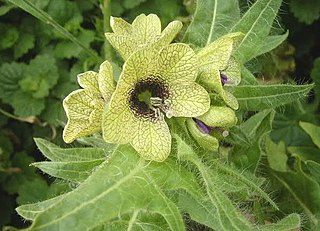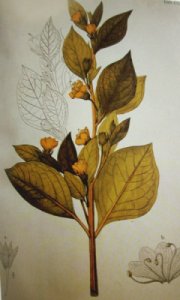
Amaryllis is the only genus in the subtribe Amaryllidinae. It is a small genus of flowering bulbs, with two species. The better known of the two, Amaryllis belladonna, is a native of the Western Cape region of South Africa, particularly the rocky southwest area between the Olifants River Valley and Knysna.

Datura is a genus of nine species of highly poisonous, vespertine-flowering plants belonging to the nightshade family (Solanaceae). They are commonly known as thornapples or jimsonweeds, but are also known as devil's trumpets. Other English common names include moonflower, devil's weed, and hell's bells. All species of Datura are extremely poisonous and psychoactive, especially their seeds and flowers, which can cause respiratory depression, arrhythmias, fever, delirium, hallucinations, anticholinergic syndrome, psychosis, and death if taken internally.

Atropa is a genus of flowering plants in the nightshade family, Solanaceae: tall, calcicole, herbaceous perennials, bearing large leaves and glossy berries particularly dangerous to children, due to their combination of an attractive, cherry-like appearance with a high toxicity. Atropa species favour temperate climates and alkaline soils, often growing in light shade in woodland environments associated with limestone hills and mountains. Their seeds can remain viable in the soil for long periods, germinating when the soil of sites in which plants once grew is disturbed by human activity or by natural causes, e.g. the windthrow of trees. The best-known member of the genus Atropa is deadly nightshade - the poisonous plant par excellence in the minds of many. The pharmacologically active ingredients of Atropa species include atropine, scopolamine, and hyoscyamine, all tropane alkaloids having anticholinergic, deliriant, antispasmodic and mydriatic properties. The genus is named for Άτροπος (Atropos) - lit. 'she who may not be turned (aside)' - one of the Three Fates and cutter of the thread of life / bringer of death - in reference to the extreme toxicity of A.belladonna and its fellow species - of which four others are currently accepted.

Atropa belladonna, commonly known as belladonna or deadly nightshade, is a toxic perennial herbaceous plant in the nightshade family Solanaceae, which also includes tomatoes, potatoes and aubergine (eggplant). It is native to Europe and Western Asia, including Turkey. Its distribution extends from Ireland in the west to western Ukraine and the Iranian province of Gilan in the east. It is also naturalised or introduced in some parts of Canada, North Africa and the United States.

Nicandra physalodes is a species of flowering plant in subfamily Solanoideae of the nightshade family. It is known by the common names apple-of-Peru and shoo-fly plant. It is thought originally to have been native to western South America, including Peru, and is known elsewhere as an introduced and ruderal species – sometimes as a weed – in tropical, subtropical and, to a lesser extent, temperate areas all over the world. It has also long been cultivated as an ornamental plant for its attractive flowers and curious fruits and has been adopted into the traditional medicine of countries far-removed from its original home.

Scopolia is a genus of four species of flowering plants in the family Solanaceae, native to Europe and Asia. The genus is named after Giovanni Scopoli (1723–88), a Tyrolean naturalist. The genus has a disjunct distribution, with two recognised species in Central to Eastern Europe,, and two species in East Asia. The two European species are:

Iochroma arborescens is a species of flowering plant in the genus Iochroma, belonging to the nightshade family Solanaceae. Formerly it was considered the single species in the monotypic genus Acnistus. Common names include gallinero, mata-gallina, fruta-de-sabiá, hollowheart, wild tobacco, siyou, bastard sirio, galán arbóreo, tabaco de monte, nigüito, marieneira, güitite, and tabak djab.

Hyoscyameae is an Old World tribe of the subfamily Solanoideae of the flowering plant family Solanaceae. It comprises eight genera: Anisodus, Archihyoscyamus, Atropa, Atropanthe, Hyoscyamus, Physochlaina, Przewalskia and Scopolia. The genera Archihyoscyamus, Atropanthe and Przewalskia are monotypic, the first being endemic to Turkey and Iran, the second to China and the third to Tibet.
Hermenegild Santapau (1903-1970) was a Spanish born naturalized Indian Jesuit priest and botanist, known for his taxonomical research on Indian flora. He was credited with the Latin nomenclature of several Indian plant species. A recipient of the Order of Alphonsus X the Wise and the Birbal Sahni Medal, he was honoured by the Government of India in 1967, with the award of Padma Shri, the fourth highest Indian civilian award for his contributions to the society.

The Solanaceae, or the nightshades, are a family of flowering plants that ranges from annual and perennial herbs to vines, lianas, epiphytes, shrubs, and trees, and includes a number of agricultural crops, medicinal plants, spices, weeds, and ornamentals. Many members of the family contain potent alkaloids, and some are highly toxic, but many—including tomatoes, potatoes, eggplant, bell and chili peppers—are used as food. The family belongs to the order Solanales, in the asterid group and class Magnoliopsida (dicotyledons). The Solanaceae consists of about 98 genera and some 2,700 species, with a great diversity of habitats, morphology and ecology.

Atropa baetica, commonly known as the Andalusian belladonna, is one of Europe's rarest wildflowers. A close relative of the infamous deadly nightshade, its specific name derives from that of the Roman province of Hispania Baetica, while its common name refers to the Spanish region of Andalucía – both designating the area in the south of Spain where it is most frequently encountered. It is an attractive perennial plant with a herbaceous habit, bearing infundibuliform, yellow or greenish flowers and shiny, black berries. Like the other three species of Atropa, it is an extremely poisonous plant, containing a variety of tropane alkaloids with anticholinergic, deliriant, antispasmodic and mydriatic properties. Although most populations of the plant are to be found in Spain, it is not wholly confined to the Iberian Peninsula of Europe, occurring also in certain localities in Morocco and Algeria in the Atlas Mountains of North Africa. The Rif and the Baetic System, which face each other across the Alboran Sea, together constitute one of the finest of the Mediterranean biodiversity hotspots – rich in endemic species, of which Atropa baetica is a notable example..

Atropanthe is a monotypic genus of flowering plants belonging to tribe Hyoscyameae of subfamily Solanoideae of the family Solanaceae.
Darcyanthus is a monotypic genus of flowering plants belonging to the family Solanaceae. The single known species is Darcyanthus spruceanus(Hunz.) Hunz. ex N.A.Harriman
Neomortonia is a monotypic genus of flowering plants belonging to the family Gesneriaceae. It just contains one species, Neomortonia roseaWiehler
Przewalskia is a genus of flowering plants belonging to the family Solanaceae.
Henoonia is a monotypic genus of flowering plants belonging to the family Solanaceae. The only species is Henoonia myrtifolia. It is native to Cuba.
Hunzikeria is a genus of flowering plants belonging to the family Solanaceae.

Metternichia is a genus of flowering plants belonging to the family Solanaceae. For a long time he only species was Metternichia principisJ.C.Mikan., but recently a second species, M. macrocalyx (Carvalho)L.S.de Souza was recognised
Nectouxia is a monotypic genus of flowering plants belonging to the family Solanaceae. The only species is Nectouxia formosa. It is in the Solanoideae subfamily and in Subtribe Salpichroinae, which is a subtribe of Physaleae.
Plowmania is a monotypic genus of flowering plants belonging to the family Solanaceae. The only species is Plowmania nyctaginoides.










